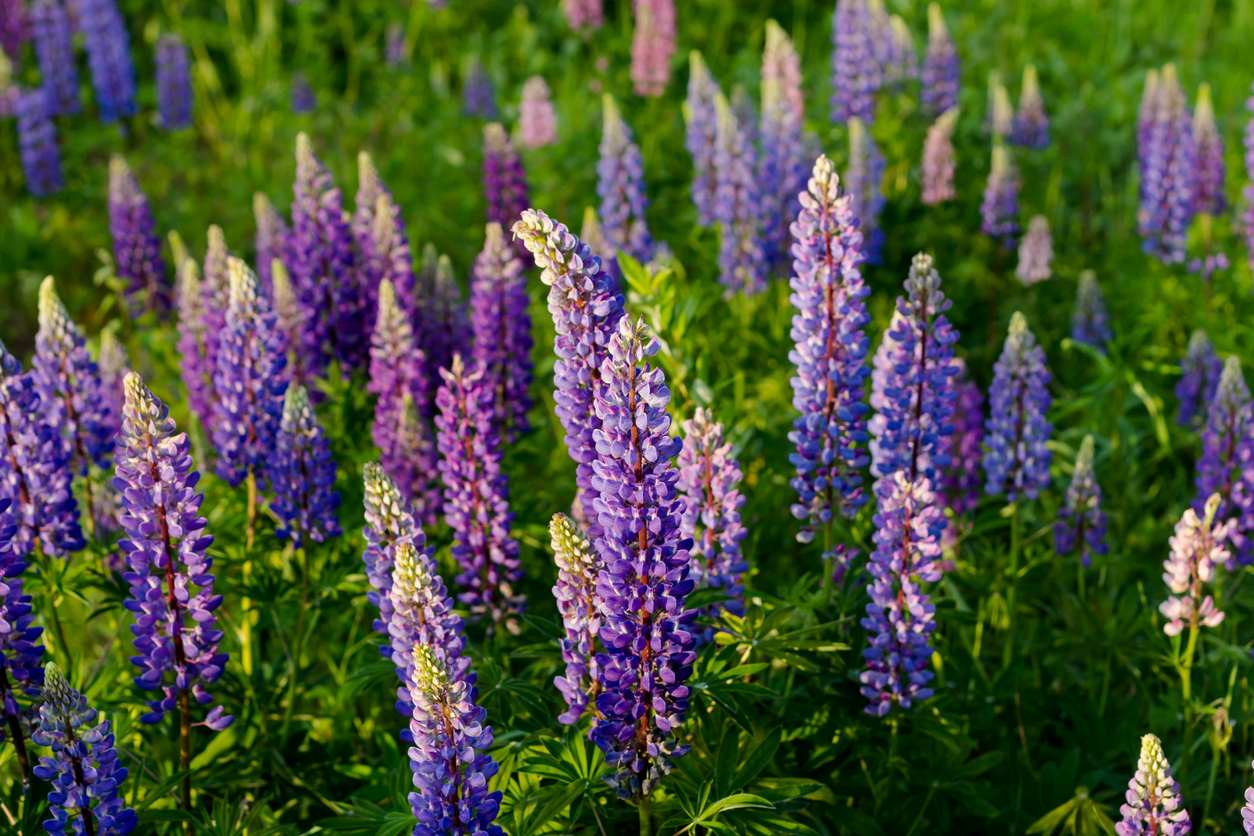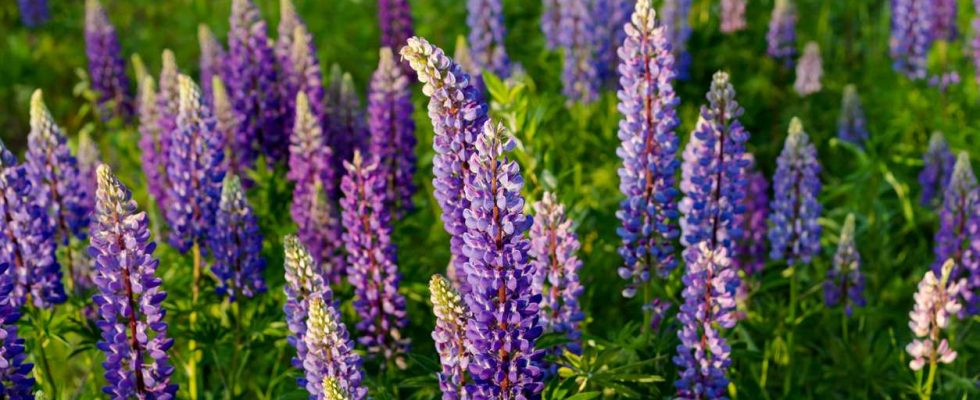
Lupine identity and cultivation sheet
| Latin name | Lupinus |
| Common name | Lupine |
| Family | Fabaceae, Legumes |
| Height | From 0.45 to 1.20 meters |
| Planting period | Spring |
| Flowering period | From June to August |
| Exposure | Sun or partial shade |
| Ground | All except limestone soils. Well-drained soil required |
| Rusticity | -15 to -20°C |
| Sensitivity | Powdery mildew, aphids |
The Lupine
From the Fabaceae family, which formerly bore the name Papilionaceae, the lupine finds its place in ornamental garden, but it is also a legume. Indeed, certain species are cultivated for food or fodder purposes. In terms of food, what makes lupine so interesting are its seeds, which are rich in protein and fiber.
The seeds of purely ornamental varieties should not be eaten, as they contain many alkaloids.
Discovering lupine
From a powerful taproot, which goes deep into the ground, comes a bushy tuft of very graphic deciduous leaves. They are, in fact, webbed and cut into leaflets arranged in rosettes.
In spring, thick flower stems bearing the characteristic spikes of lupine emerge from this tuft of leaves. These ears, made up of a multitude of small, fragrant and brightly colored flowerswhich hatch from the bottom upwards, rise like arrows, can reach up to 60 cm high.
When the flowers fade, the ears turn into pods which contain the seeds. These seeds can resow spontaneously and as we saw previously, some can be eaten.
Lupine species
The Lupine genus includes more than 600 species, some of which are annuals and others perennials.
Perennial species
- Russell’s hybrid lupine: the most widespread species in our country. It comes in many varieties such as ‘Le Chandelier’, ‘La Châtelaine’, etc. It is a vigorous ornamental plant which can reach 80 cm high and flowers from May to June. If you cut the spikes immediately after they have faded, taking care to preserve as much foliage as possible, then you may have the chance to enjoy a second flowering.
- Lupinus arboreus, or tree lupine: it can reach 1.50 m in height and is characterized by a bushy habit. It may be necessary to protect it in winter since it cannot withstand temperatures below -12°C.
Annual species
- Lupinus lupeus, or yellow lupine: This lupine with yellow flowers can reach a height of 50 cm and constitutes a very good green manure.
- Lupinus hartwegii, or Hartweg lupine or hairy lupine: it flowers from July to September. It is a semi-dwarf species that can reach 60 cm in height. This lupine is characterized by velvety foliage.
- Lupinus cruckshanksiior changing lupine: this lupine with a bushy habit can reach 1 meter high and is characterized by palmate bluish-green foliage.
Edible species
- Lupinus albus, or white lupine : large-grained sweet white lupine is a variety whose seeds can be consumed in the form of pickled seeds, flour or cakes.
Lupine Growing Conditions
Because it is very rustic, lupine can be grown anywhere in France. It supports temperatures down to -15 to -20°C. As for its exhibition, it requires to be installed in a sunny location or possibly in partial shade.
He hates limestone soils. It prefers ordinary soils with an acid tendency, light and well drained which remain cool in summer. It is even able to cope with poor soil, but its flowering will be less impressive.
When planting or sowing lupins, remember that its taproot must be able to sink deep into the ground and that on the surface, it needs space to develop.
The seeds will be able to germinate when temperatures are between 10 and 20°C.
Planting or sowing lupines
To have lupins in your garden you have the choice between sowing seeds or buying young plants in pots to transplant.
Sowing lupins
You have the choice between sowing seeds under cover in the fall or sowing them directly in place in spring, when the soil has warmed up, since the seeds need a temperature between 10 and 20°C to germinate.
Sow your seeds under cover
If you opt for this solution, it will then be necessary to transplant the young plants when they are between 4 and 5 cm. Proceed as follows:
- In pots filled with potting soil, place 3 seeds.
- Lightly cover the seeds with potting soil and moisten.
- Let your seeds germinate in a warm, light place.
- In spring, transplant the young plants without tightening them too much, as they will develop quickly.
- Lightly pack the soil around each foot.
- Carry out watering.
Sow your seeds directly in place
Proceed as follows:
- Sow in pockets of 3 seeds in holes 3 to 5 cm deep, leaving a space of 20 to 30 cm between the pockets.
- During germination, which takes about 3 weeks, water moderately but regularly.
- After the seeds emerge, only keep the most vigorous plants and remember to weed regularly.
Planting lupins
To create a beautiful mass in your garden, group planting is recommended, that is to say up to 4 feet per square meter. Whether you transplant lupins sown under cover or lupins purchased in pots, here is the procedure to follow.
- Prepare a hole 2 to 3 times larger than the size of the bucket.
- Since lupine hates excessive humidity, create a drainage bed at the bottom of the hole with clay balls or coarse sand or gravel.
- Fill in a third of the hole with a mixture of garden soil, compost and equal parts.
- Install the plant so that the collar is at ground level.
- Finish filling the planting hole.
- Pack and water.
If you wish, you can also plant lupins in pots. Dwarf varieties are most suited to this method of cultivation. To fill the pot, you can then opt for potting soil with added sand.
Maintaining the lupine
Growing lupine is easy and within the reach of all gardeners, especially as it requires little maintenance. Here are the few points that require your vigilance.
- The lupine is quite greedy in water. During the vegetation period it is important to water it regularly, preferably with rainwater, because, as we have seen, it hates limestone. Once it is well established, it is able to withstand brief episodes of drought.
- To keep the soil coolit is recommended to install mulch around the base.
- If your land is poordo not hesitate to add compost.
- Remove spent flowers. You will therefore have a greater chance of benefiting from a second flowering.
- As soon as the flower stalks no longer bloomcut them.
- Even though they are perennial plants, over the years, lupins lose their vigor and then die. To counter this problem, divide the clumps every 2 or 3 years.
- In spring, when vegetation starts, cut your lupins in half. This will encourage the appearance of new shoots.
Companion plants
You can grow lupine alongside hollyhocks, escholtzias, but also carnations.

